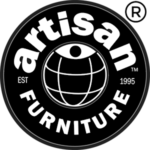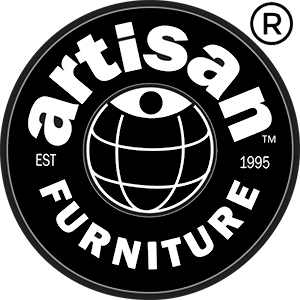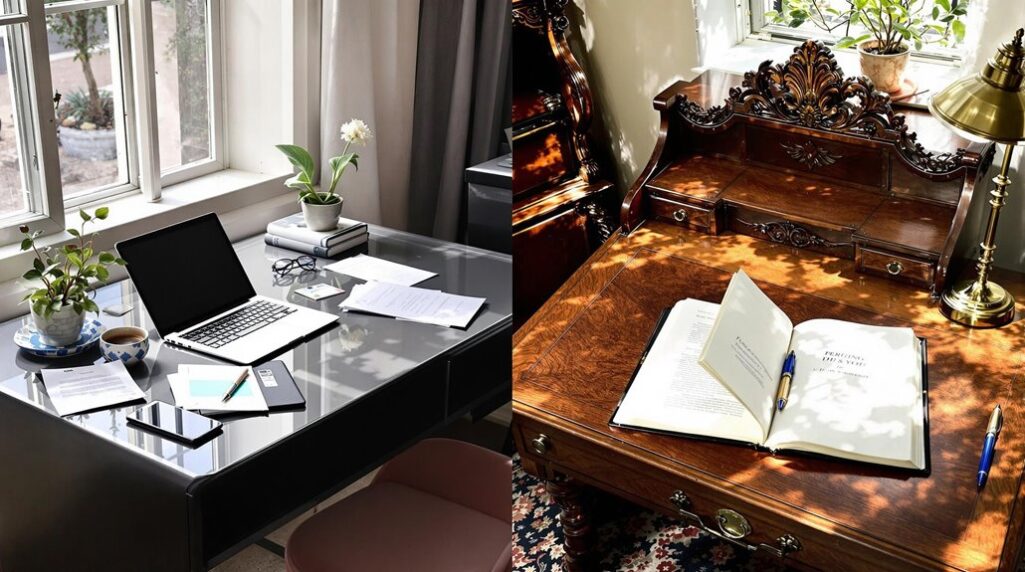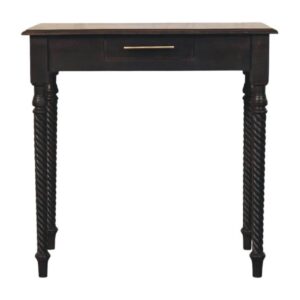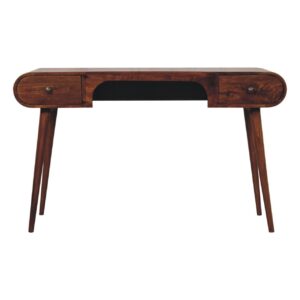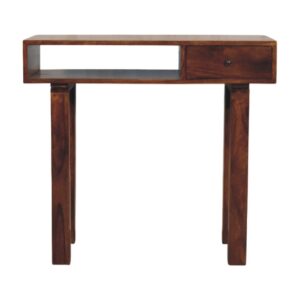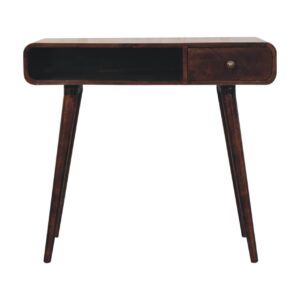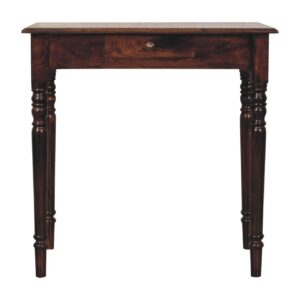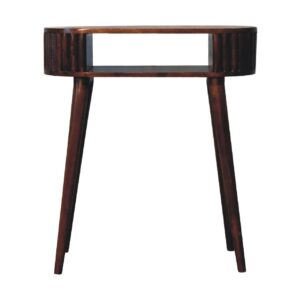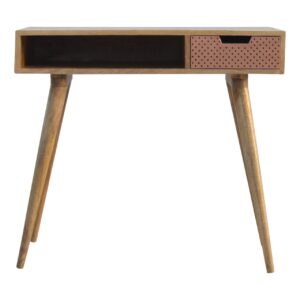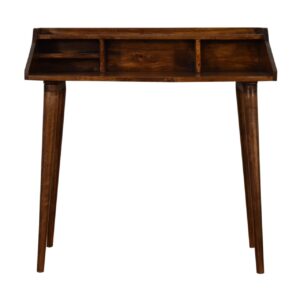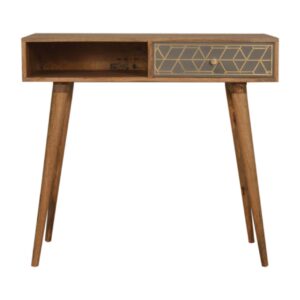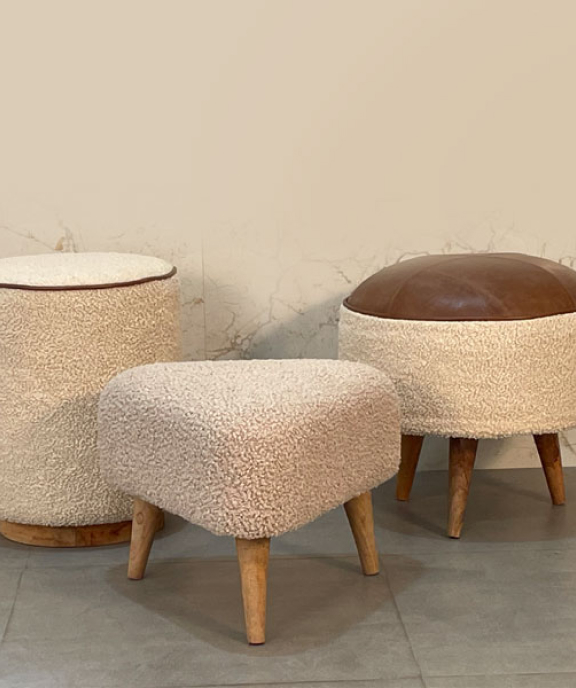The primary difference between a desk and writing desk is their structure and purpose. A desk offers a wide area to spread out your projects. It includes various storage options such as drawers and shelves, making it perfect for studying, writing, or working from home.
In contrast, a writing desk features a streamlined, straightforward design focused on function. It provides less surface area, ideal for smaller tasks such as writing or reading. Writing desks tend to be smaller and lighter, making them a better fit for snug spaces or home offices.
A desk is more multipurpose and suited for different activities, while a writing desk prioritizes style and dedicated usage. Knowing these differences will allow you to determine which is the best option for you based on your needs and space requirements.
- Desks are dynamic pieces of furniture used for productive tasks like writing, computing, and keeping organized. Writing desks intentionally set themselves up to support deliberate and engaging writing experiences.
- Often smaller and more minimalist in design, writing desks are perfect for smaller bedrooms or carving out a distraction-free workspace.
- Desk construction Desk with wood, metal, and glass Elegant wood types like cherry or oak are prominent in writing desks, ensuring lasting beauty and function.
- Writing desks emphasize a more straightforward and imaginative approach, whereas standard desks tend to focus on accommodating multiple tasks and the use of technology.
- Ergonomics are of utmost importance when it comes to standing desks or a writing desk. Overall work desks, though, tend to offer greater ergonomic flexibility to improve comfort.
- When choosing a desk, evaluate your specific needs, available space, and budget, and consider long-term durability and functionality for the best investment.
What is a Desk?
A desk is an infinitely configurable, multi-purpose work surface. It’s an ideal space for reading, studying, crafting, or technology use such as on a laptop. This almost always entails some sort of level surface.
It frequently includes storage features, such as drawers or open shelves for storing documents, writing utensils and other materials. Desks are the focal point in any workspace, whether at home or in an office, creating a platform for ideas to flourish and thoughts to organize.
Though desks of the past may have been narrow and decorative, contemporary designs focus on utility, frequently including ergonomic attributes to promote comfort and wellbeing.
General Purpose and Characteristics
Desks provide a focused work environment for activities such as computing, studying, or crafting. An organized desk contributes to the ability to focus and complete tasks, making this arguably one of the most productive factors.
They can be minimal, multifunctional, or anything in between, serving different purposes and audiences. Other desks feature cable management systems or even adjustable heights, increasing their versatility in use.
An L-shaped large study desk provides plenty of workspace, making it ideal for students. Practitioners generally like desks that include integrated storage.
Common Desk Materials
Desks are traditionally produced using materials such as wood, metal, and glass. Wooden desks are ideal for durability and a timeless aesthetic, while metal desks are perfect for a contemporary, industrial vibe.
Glass desks are incredibly chic, but they are more fragile and need to be treated more carefully. Material choices directly impact the desk’s weight, stability, and appearance, influencing both function and décor.
Typical Desk Sizes
Desk sizes can run the gamut to accommodate any area, from a small writing desk for cramped quarters to larger styles like executive desks for expansive offices. Additionally, each dimension and height must correlate with ergonomic specifications to provide a practical workspace solution for comfortable long-term use.
What is a Writing Desk?
A writing desk can be a versatile style of work surface, often purpose-built to create a more dedicated space for productive writing tasks. Different from big, multifunctional desks, it keeps things minimal by just providing an open space to work.
Writing desks are ideal for letter writing and journal keeping. They’re equally at home with light computer use, too, which makes them a compelling option for everyday home and business use.
Defining Features of Writing Desks
Writing desks typically have a simple aesthetic that encourages creative thought and concentration. Typical features are one or two drawers or small cubbies for storing items like pens, notebooks or other office supplies.
The minimal work surface and no-frills approach mean you can focus solely on your writing with as few distractions as possible. Their contemporary designs and small footprint make the writing desk a perfect complement to any décor.
Their self-sufficiency makes them ideal for tight-knit rooms or studio apartments.
Historical Context and Evolution
In the past, writing desks were incredibly important in every home and office, as a private place to conduct their correspondence and keeping records. Early designs focused on detailed artisanship, with key designers such as Thomas Chippendale contributing to their evolution.
They tweaked and iterated to respond to today’s challenges. Today, they’ve become more streamlined, supporting laptops and tablets, mirroring the ways we write and create now.
Writing Desk Material and Construction
Cherry and oak are very popular materials for creating writing desks, prized for their sturdiness and classic beauty. Cherry wood, in specific, is known for its smooth and very fine grain, making it the ideal choice for an exceptional aesthetic and tactile experience.
Premium quality craftsmanship ensures that these desks will serve you well for years to come. Beyond their looks, they stay functional, which is why these pieces are such an amazing addition to any workspace.
Desk vs. Writing Desk: Key Differences
Whether you are deciding on a small writing desk versus a computer desk, knowing their differences in purpose, design, and functionality is important. Both surfaces function as productive workspaces, but each type of desk provides different attributes, making them uniquely suited to various tasks and environments.
1. Functionality: Task-Oriented Design
Writing desks are strictly work oriented for such tasks as writing, reading or other focused activity. They provide a sleek design, typically featuring a clean top and little or no storage, focusing on an uncomplicated aesthetic that pairs perfectly with any decor.
Desks are more multifunctional, accommodating everything from computer work, study, or just good old-fashioned multitasking. All modern desks come equipped with advanced features such as cable management systems and pull-out keyboard trays.
These features are what makes them ideal across all home office tasks. This functional task-oriented design is pragmatic. Its ergonomic design really makes a difference to daily productivity by matching the desk’s purpose to your workday needs.
2. Design: Form Follows Function
Writing desks are often designed with a more refined, sophisticated aesthetic in mind, showcasing a sense of craftsmanship steeped in tradition. Their minimalism makes them easy to use without frustrating distractions.
Today’s desks, especially computer desks, are loaded with all the great functions. They frequently feature integrated storage and ergonomic features that add value to the technology experience.
Whether in the home or office, both designs equally prioritize aesthetics and function. Whichever the case, pick the one that speaks to your values—timeless simplicity or tech-friendly features.
3. Size and Layout: Space Optimization
Writing desks are small and unobtrusive, perfect for use in tight spaces or a dedicated nook. Desks, on the other hand, are less defined in their size and can be made to fit several users or larger equipment.
Taking into account room size and workflow requirements is important to make sure the desk operates smoothly and fits comfortably in your space.
Functionality: Beyond the Surface
Desks today are more than just a surface for getting work done. They serve versatile purposes that are deeply embedded in how we communicate, innovate and document our lives. A beautiful, smartly designed task desk integrates their devices and inspires creativity. That innovation design and purpose truly lifts your productivity and personal comfort to new heights.
Making an informed choice Selecting the appropriate desk depends on knowing these functional distinctions and matching them up with one’s own needs.
Desks for Multitasking
To support multi-tasking, a good desk has lots of surface area. This spacious feature helps to mix and match a variety of devices and tools with ease. Office computer desks are designed with removable cable management, fold-away keyboard trays and adjustable monitor stands.
These adjustments turn them into ideal devices for anyone who juggles several monitors, printers and different devices. Organization is key here, as desks that include built-in drawers or modular, self-sorting compartments provide a long-necessary means for managing clutter.
Modular desks, which seat a variety of postures and sizes, are increasingly prevalent in collaborative environments, marrying functionality with aesthetics and compact design.
Writing Desks for Focused Work
Writing desks are designed to promote focused work. Their simple aesthetic lends itself to a small footprint. It prevents compartmentalization, lowers distractions, and provides a clean workspace.
Having a dedicated writing desk can help to spark creativity. It’s that functionality that lets users really dive deep into their work, whether they’re drafting an important report or brainstorming new ideas.
Buying a good writing desk is an investment in your comfort. It fosters an uplifting work environment, something vital, particularly for those who clock-in long hours at their desks.
Adapting to Different Work Styles
Flexibility for multiple uses and activities is key in desk design. Adjustable heights, ergonomic designs, and flexible layouts allow workers to interact in the ways that best serve their unique working styles.
Take, for instance, a desk that promotes standing posture versus one that allows for traditional sitting posture with plenty of space to stretch out. Choosing a desk that accommodates individual preferences sets the stage for a more efficient and tailored work environment.
Design and Aesthetics: A Visual Comparison
When it comes to desk types, such as writing desks and office desks, the design and aesthetics are what really set these two apart. These elements are critical not only to functionality but to the overall mood and energy of your workspace.
Modern Desk Designs
Today’s desks feature clean lines and crisp, simple silhouettes. They work beautifully with today’s micro-trends like mid-century modern, industrial, and Scandinavian designs.
These designs take advantage of technology, providing discreet cable management systems or built-in charging ports to minimize clutter. A metal-and-glass desk, for example, says chic and modern but keeps things grounded.
In contemporary design, form follows function. Multipurpose elements like height-adjustability and ample storage options add to the versatility that makes these designs ideal for quickly shifting offices.
Classic Writing Desk Styles
Traditional writing desks value quality construction and refinement. A traditional wooden desk with two or three simple drawers provides workstation function infused with classic style.
Ornate reliefs, subtle fluted lines and high quality native hardwoods add to an unmatched aesthetic appeal. Infusing a sense of history and romance, these pieces create a sumptuous atmosphere that will warm even the coldest ballroom.
Vintage writing desks are characterized by gleaming, shiny finishes and elaborate details. In the right spaces, they can stand out in striking, beautiful ways, and contrast beautifully with sleek modern decor.
Personalizing Your Workspace
DIY personalizing a personal creative station—be it a desk, a nook, or a corner—boosts creativity and motivation. Incorporating personal decor such as plants, desk organizers, or artwork can help express personal style, boost creativity, and enhance wellbeing.
A desk with an ideal working height of 71–76 cm guarantees the ergonomic balance needed for even higher daily working hours. Research indicates that the majority of 80% individuals feel that a well-designed workspace increases their productivity, further proving that it’s key to tailor your environment.
Ergonomics and Comfort Considerations
When deciding between a desk and a small writing desk, prioritize ergonomics first. This choice is key to staying healthy and enhancing your overall productivity. The design of the workstation desk directly impacts posture, comfort, and usability, making it essential to understand your ergonomic needs before making a choice.
Posture and Desk Height
Regular desk height helps in achieving the correct posture. The best desk height allows a 90- to 110-degree angle at the elbow. In addition, it allows you to use a supine position which puts less stress on your shoulders and arms.
Adjustable surfaces provide range to adapt to various users and teach people how to incorporate sitting and standing. This simultaneously enhances circulation and decreases the likelihood of back pain, obesity, and diabetes by 11%.
Placing your computer monitor at eye level, 50 to 75 centimeters away, will save you a lot of neck and eye strain, too.
Importance of Proper Seating
Seating is just as important as the desk in creating an ergonomic workspace. Ergonomic chairs offer lumbar support, adjustable armrests and seat depths of 42 to 47 centimeters for ideal comfort.
Choosing the correct chair to accompany your sit-stand desk will keep you in an ergonomic posture, reducing fatigue during those long workdays. Investing in memory foam back pillows or high-quality padded armrests can take comfort up another notch.
Preventing Strain and Discomfort
Bad ergonomics in relation to desks contribute to discomfort and fatigue. To avoid injury, desks must be practical and scaled to fit into your working environment.
Taking frequent breaks with the 20-20-20 rule and integrating sit-stand desks to promote movement can help combat muscle stiffness. Tilt screens back 10–20 degrees as a way to reduce glare and help protect eyes and eyesight.
Choosing the Right Desk for You
Taking the time to select the right desk is more than simply choosing a functional workspace. It’s all about identifying what works best for you, what enhances your environment, and what fuels your productivity from morning through night.
Whether you’re choosing a secretary desk or a traditional writing desk, knowing what you need and what you love makes all the difference.
Assess Your Needs and Space
Start by asking yourself a few key questions:
- How will you primarily use the desk?
- Do you need storage like drawers or shelves?
- Would height adjustability benefit your work habits?
Then, measure the width and length of the space you have to work with in your room. Consider your space. For instance, if you’re writing in a small nook, a writing desk with a narrow silhouette might be the best fit.
More spacious areas could make room for an L-shaped desk, offering lots of real estate for the ultimate multitasking setup. Think about your needs in terms of usage and features. If you sit more than four hours a day, a standing desk WILL improve your health.
Consider Your Budget
Your budget is absolutely essential in whittling their best candidates. Though it’s tempting to pick the lowest options, finding the right equilibrium between price and quality will get you something that lasts long.
Desks made of dense woods, examples of which include oak, teak or mahogany, will resist wear better and maintain their looks longer. Find something in every price range.
In this manner, you’re going to be able to pick out an appropriate desk to fit your budgetic and practical priorities.
Think Long-Term Investment
A desk shouldn’t be just a stopgap buy ─ it’s an investment in your productivity and comfort. Hardwearing constructions such as solid hardwood and standing desks are built to endure everyday wear and tear.
Plus, they beautify your workspace! If you prioritize quality over trinkets and trends, you’ll reap the rewards in the long term.
Modern Trends in Desk Design
The evolution of desk design is a mirror into how we work and live, integrating needs, beauty, and imagination. The modern desk has moved past just being a work surface. They have transitioned into a creative blend of glamour, function, and green living, appealing to diverse tastes and lifestyles.
From standing desks to technology integration and sustainable materials, modern trends are changing the way we view furniture designed for workspaces.
Standing Desks and Adjustable Options
Standing desks have become widely popular to encourage better posture and less sedentary behavior. They give users the flexibility to move between sitting and standing, helping users stay more focused and energetic throughout their day.
Adjustable desks, meanwhile, as you can set the height, are perfect for different work styles if you need to sketch, type, or work together. Flexibility is at the heart of contemporary design.
We’re already witnessing this in environments that readily accommodate flexibility for different work modes, from co-working environments to the home office. For example, desks that raise and lower with a hydraulic or electric lift are now the industry norm, providing ease of movement and comfort.
Incorporating Technology
Technology has played a huge role in desk design and function, increasing productivity and visual appeal. Tech-friendly design features such as cable management systems, built-in charging ports, and wireless charging pads appeal to tech-savvy users.
For instance, 80% of people say effective cable management is important for keeping a clean and tidy workspace. Writing desks with readily available USB ports or expansive computer desks with multilayer shelving units for tech equipment are perfect examples of this trend.
These choices in turn foster a seamless, integrated and efficient work environment conducive to collaboration and innovation.
Sustainable and Eco-Friendly Choices
There’s a huge sustainable materials market emerging with bamboo, reclaimed wood and metal being in high demand. Sustainable furniture manufacturing reduces negative effects on the environment and promotes preservation of natural resources for future generations.
Opting for environmentally friendly desks contributes to a healthier planet while infusing warmth and character into spaces. Popular styles including mid-century modern or Scandinavian make abundant use of sustainable materials, combining classic look with eco-friendly practice.
Desks and writing desks have their own respective strengths that make them great, but each possesses different advantages. Desks are more spacious for multi-tasking needs, but writing desks are more about simplicity and sophistication for concentrated work. Whether they be large or small, your decision should be based on what accommodates your everyday function, environment, and aesthetic. A busy home office might benefit from a standard desk, while a quiet corner could shine with a writing desk’s charm.
Both choices are available in contemporary styles to match today’s homes. Whatever it is you’re seeking—function, aesthetics, or a balance of the two—there’s plenty to choose from. Do your research, understand your environment, and choose what’s going to fit your needs and life the best.
See all of your options today and discover the desk that’s right for you.
